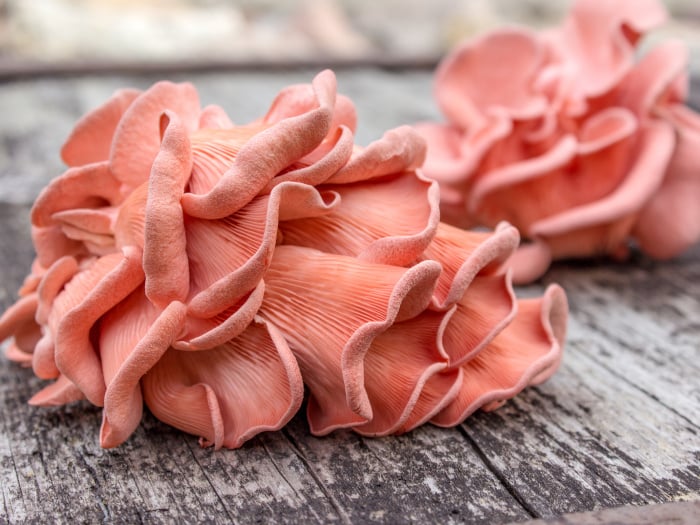Pink oyster mushrooms, with their stunning ruffles and beautiful pink blush, are perhaps one of the most photographed mushrooms on Instagram. These pastel-colored beauties taste delicious when tossed simply with olive oil, salt, and pepper and added to salads. They are also good for your overall health. Let’s find out more.
Pink Oyster Mushrooms
Pink oyster mushrooms (Pleurotus djamor) are edible tropical mushrooms that grow in clusters on hardwood trees. These mushrooms belong to the Pleurotaceae family, of which the most common is the greyish-white oyster mushroom. Pink oyster mushrooms have a strong woodsy aroma and are tougher in texture than other oyster mushrooms. However, this variety has a very short shelf life and needs to be eaten within hours of it being harvested. You can extend its shelf life by storing it in the refrigerator for a day, but it may not retain its smoky aroma. You can buy these delicate mushrooms from a farmer’s market or you can grow it with an oyster home growing kit using sawdust, wood, paper, or hay in a warm and humid climate. [1] [2]
This variety of oyster mushrooms is also known as pink flamingo mushrooms, salmon oysters, or strawberry mushrooms due to its distinctive light pink color. The color intensifies when the mushrooms receive adequate light.

Pink oyster mushrooms have a beautiful appearance and blush color. Photo Credit: Shutterstock
Nutrition & Health Benefits
Pink oyster mushrooms share a similar nutrient profile as oyster mushrooms. They have a high protein and fiber content. They also are a rich source of B vitamins, potassium, copper, selenium, and folate. According to research, oyster mushrooms contain an antioxidant called ergothioneine, which may reduce plaque build-up in arteries and improve heart health. Studies show that these mushrooms have potent antinociceptive, antitumor, antioxidant, and immunological activities. Furthermore, a 2010 animal model showed that pink oyster mushrooms have the potential to boost immunity levels. [3] [4] [5] [6] [7]
In terms of calorie content, a cup of sliced oyster mushrooms only 28.4 calories, 5.2 grams of carbohydrates, and 2.85 grams of protein. [8]
How To Use Pink Oyster Mushrooms?
These blush-colored beauties are stunning to look at but unfortunately, they do not retain their beautiful color when cooked. They have a distinctive meaty taste, reminiscent of bacon or ham. This is one of the reasons you can use pink oyster mushrooms as a meat substitute in vegetarian dishes.
While oyster mushrooms are mostly used in Asian dishes, you can use them in pasta, soups, and as a pizza topping. They are perfect for roasting and sautéeing as these cooking methods allow the oyster mushroom’s complex flavors to develop fully.
The best way to cook the mushrooms is to coat them with olive oil or sesame oil and your favorite spices or herbs. Add them to a hot pan and stir-fry. Make sure that you cook them till all the liquid evaporates and the mushrooms become smaller in size because otherwise, they may have a bitter flavor. They take about 15-20 minutes to be cooked well. You can also quickly tear the bigger mushroom up or cut them roughly for rustic dishes. Here are some ways you can use pink oyster mushrooms.
- Roast them till brown and chop into tiny pieces. These can serve as bacon bits to be sprinkled over Sautéed Green Beans with Garlic or any of your favorite side dishes.
- You can also use it in pilafs, couscous, and salads. We recommend putting it on this Hearty Potato Salad for added flavor and texture.
- You can use sautéed oyster mushrooms instead of seafood in chowder recipes.
Word of Caution: This variety of oyster mushrooms is usually found in select stores and local markets due to its short shelf life. They are several oyster home growing kits also available online. These are safer options than foraging for wild mushrooms in the woods without an experienced professional. There are poisonous look-alike oyster mushroom varieties that can cause health problems like nausea, vomiting, or diarrhea. [9] [10]
